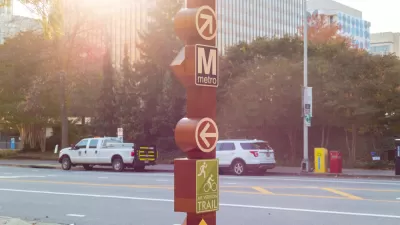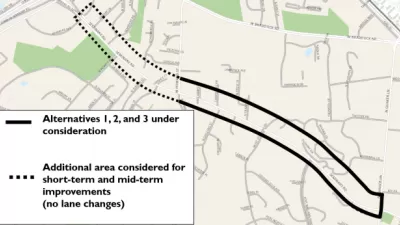When it comes to intersections, adding more complexity can do more harm than good, according to a recent, detailed post on Greater Greater Washington.
Ben Ross decries the growing complexity of traffic signals at intersections all over the country, which might be better at distracting drivers than they are at directing them.
Ross selects the "intersection of doom" in Arlington—where Mount Vernon Trail turns into Custis Trail at the foot of the Key Bridge in Arlington—as a case study of unnecessary complexity in traffic signals and intersection design. There, explains Ross, "Drivers must simultaneously watch for cars coming from the left, cyclists and pedestrians entering the crosswalk from the right, and an overhead signal that went in in January that flashes a no-right-turn graphic for a few seconds during the leading pedestrian interval." Moreover, "the no-right-turn graphic is hard to see in bright light, and it is flanked by highly visible signs that seem to say turns are allowed."
According to Ross the arrangement of this intersection is common around American cities—the only thing remarkable about it is the large number of bikes and pedestrians travelling through the intersection.
The article goes on to discuss larger concepts that inform an understanding of how intersections like this fail to meet a goal of reliably keeping roads safe. Ross notes especially that two concepts are missing from traffic engineering guidelines: redundancy and parsimony. "Redundancy means backups for missed signals and improper actions. Parsimony means signals aren't excessively complex."
FULL STORY: Complex traffic signals make streets less safe

Alabama: Trump Terminates Settlements for Black Communities Harmed By Raw Sewage
Trump deemed the landmark civil rights agreement “illegal DEI and environmental justice policy.”

Study: Maui’s Plan to Convert Vacation Rentals to Long-Term Housing Could Cause Nearly $1 Billion Economic Loss
The plan would reduce visitor accommodation by 25% resulting in 1,900 jobs lost.

Planetizen Federal Action Tracker
A weekly monitor of how Trump’s orders and actions are impacting planners and planning in America.

Waymo Gets Permission to Map SF’s Market Street
If allowed to operate on the traffic-restricted street, Waymo’s autonomous taxis would have a leg up over ride-hailing competitors — and counter the city’s efforts to grow bike and pedestrian on the thoroughfare.

Parklet Symposium Highlights the Success of Shared Spaces
Parklets got a boost during the Covid-19 pandemic, when the concept was translated to outdoor dining programs that offered restaurants a lifeline during the shutdown.

Federal Homelessness Agency Places Entire Staff on Leave
The U.S. Interagency Council on Homelessness is the only federal agency dedicated to preventing and ending homelessness.
Urban Design for Planners 1: Software Tools
This six-course series explores essential urban design concepts using open source software and equips planners with the tools they need to participate fully in the urban design process.
Planning for Universal Design
Learn the tools for implementing Universal Design in planning regulations.
Caltrans
Smith Gee Studio
Institute for Housing and Urban Development Studies (IHS)
City of Grandview
Harvard GSD Executive Education
Toledo-Lucas County Plan Commissions
Salt Lake City
NYU Wagner Graduate School of Public Service





























